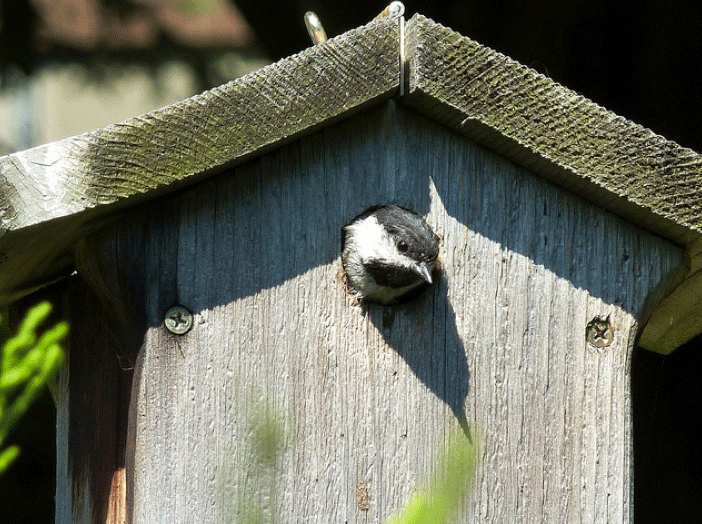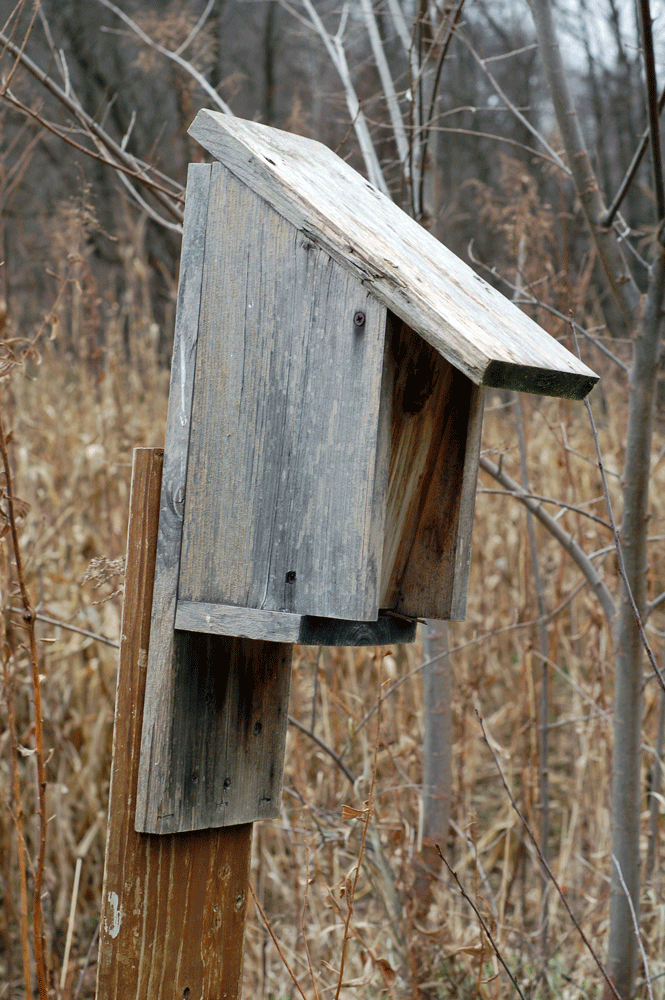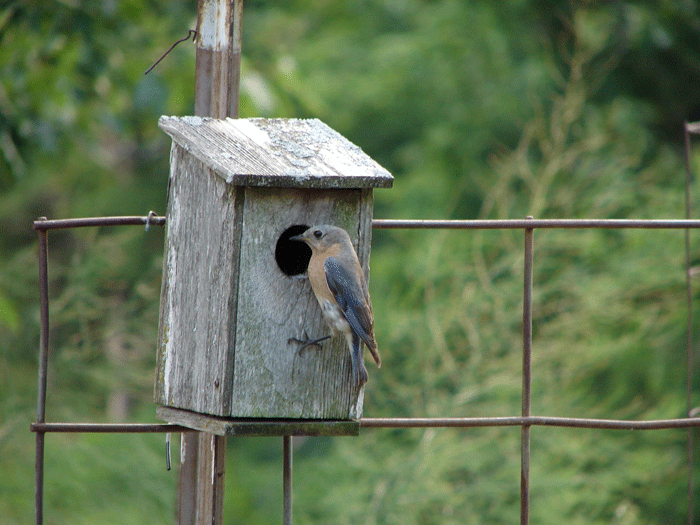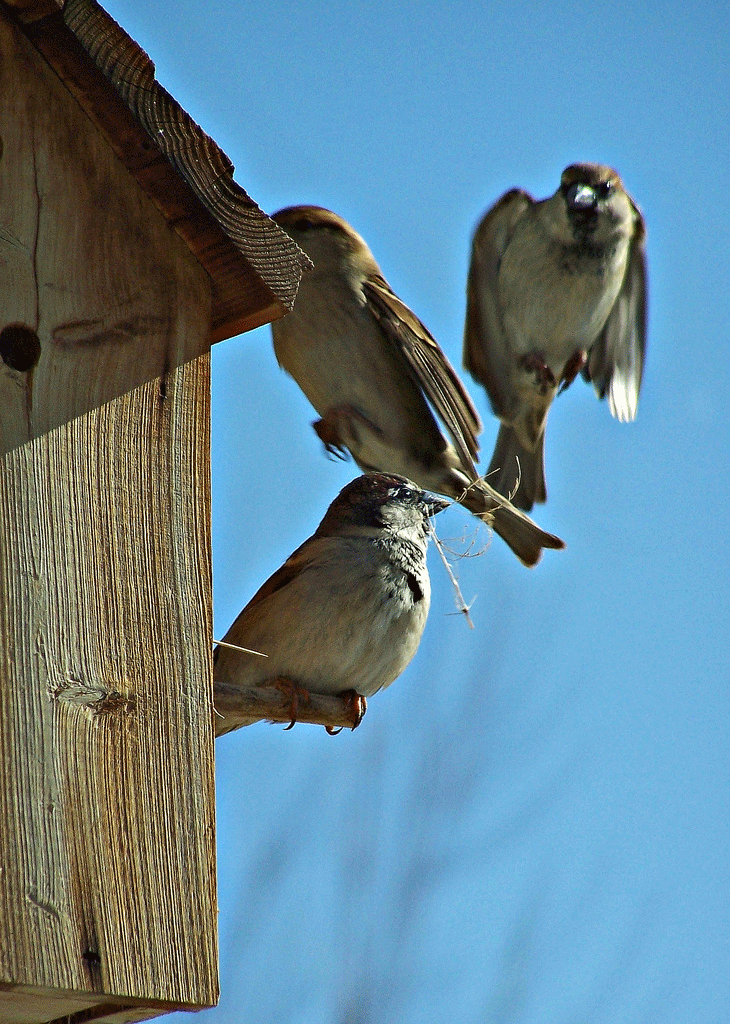BirdNote — The Perfect Nest box
Air Date: Week of May 2, 2014

The "perfect nest box" and the tenant, a native Black-capped Chickadee (photo: Susan Robertson)
The key to attracting native birds to your garden is to offer them some food and the ideal home - and as Michael Stein explains, that means the perfect nest box. (2:00)
Transcript
CURWOOD: If you want to see birds in your yard - there's no better way than to feed them - and encourage them to hang around by giving them somewhere appealing to live.
Sometimes, though, all one seems to attract are the ubiquitous starlings and sparrows.
So in today's BirdNote®, Michael Stein has some words of advice.
BirdNote®
The Perfect Nestbox
[SONGS OF HOUSE WREN, BLACK-CAPPED CHICKADEE, AND RED-BREASTED NUTHATCH]
STEIN: We’re hearing a House Wren
[HOUSE WREN SONG]

Sloped roof protects from weather and predators (photo: Ladyheart)
A Black-capped Chickadee
[BLACK-CAPPED CHICKADEE SONG]
And Red-breasted Nuthatch
[RED-BREASTED NUTHATCH CALL]

Female bluebird at home in a rustic nest box (photo: NDPetitt)
One of these birds might make its home in your yard, if you put up the right kind of birdhouse. They’re all “cavity-nesters,” birds that need a cavity in a tree—or a birdhouse that serves the same purpose—for nesting.

Perches invite non-native House Sparrows (photo: Steve BroGuggs)
[MORE MEDLEY]
Look for a nestbox that’s plain wood, none of that fancy stuff. Birds prefer their nest sites to be inconspicuous. If the birdhouse comes with a cute little dowel perch, remove it. The nesting birds don’t need the perch. And it just makes it easier for a predator bird to land and go after the eggs or young. Here’s the important part: grab a ruler and measure the entrance hole. It should be 1-1/8 inches. No more, no less, exactly one and one-eighth inches. If the entrance hole is too big, use an adapter to reduce the size. That size will let native birds in, and keep non-natives out. Now hang the box where it’s out of reach of any predator.
I’m Michael Stein
[MORE MEDLEY]
[Written by Frances Wood
Calls and songs of the birds provided by The Macaulay Library of Natural Sounds at the Cornell Lab of Ornithology, Ithaca, New York. Black-capped Chickadee song, House Wren and Red-breasted Nuthatch call recorded by G.A. Keller.
Producer: John Kessler
Executive Producer: Chris Peterson
© 2014 Tune In to Nature.org May 2014 Narrator: Michael Stein
http://birdnote.org/show/perfect-nestbox ]
CURWOOD: Hop on over to our website, LOE.org for some cute pictures of these native birds.
Links
Living on Earth wants to hear from you!
Living on Earth
62 Calef Highway, Suite 212
Lee, NH 03861
Telephone: 617-287-4121
E-mail: comments@loe.org
Newsletter [Click here]
Donate to Living on Earth!
Living on Earth is an independent media program and relies entirely on contributions from listeners and institutions supporting public service. Please donate now to preserve an independent environmental voice.
NewsletterLiving on Earth offers a weekly delivery of the show's rundown to your mailbox. Sign up for our newsletter today!
 Sailors For The Sea: Be the change you want to sea.
Sailors For The Sea: Be the change you want to sea.
 The Grantham Foundation for the Protection of the Environment: Committed to protecting and improving the health of the global environment.
The Grantham Foundation for the Protection of the Environment: Committed to protecting and improving the health of the global environment.
 Contribute to Living on Earth and receive, as our gift to you, an archival print of one of Mark Seth Lender's extraordinary wildlife photographs. Follow the link to see Mark's current collection of photographs.
Contribute to Living on Earth and receive, as our gift to you, an archival print of one of Mark Seth Lender's extraordinary wildlife photographs. Follow the link to see Mark's current collection of photographs.
 Buy a signed copy of Mark Seth Lender's book Smeagull the Seagull & support Living on Earth
Buy a signed copy of Mark Seth Lender's book Smeagull the Seagull & support Living on Earth

